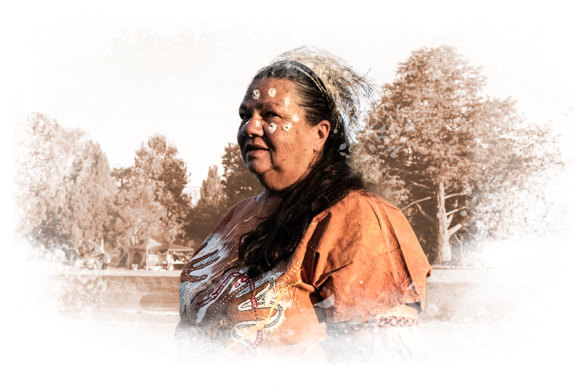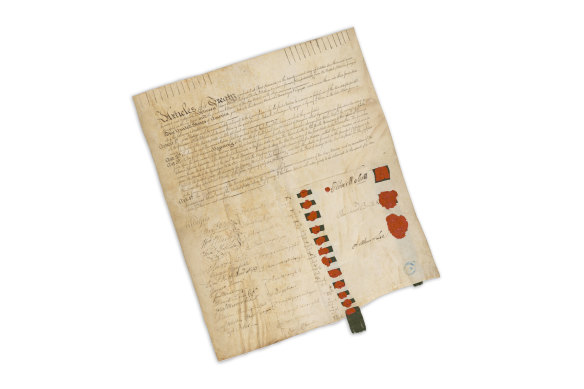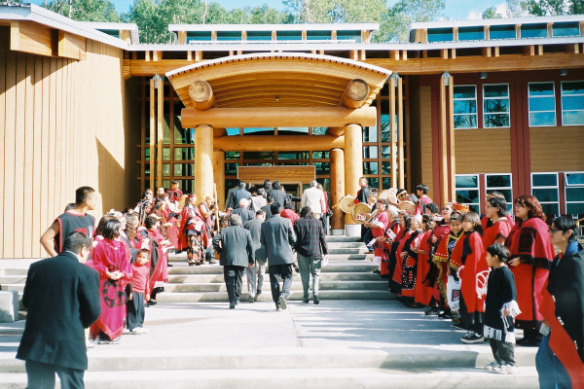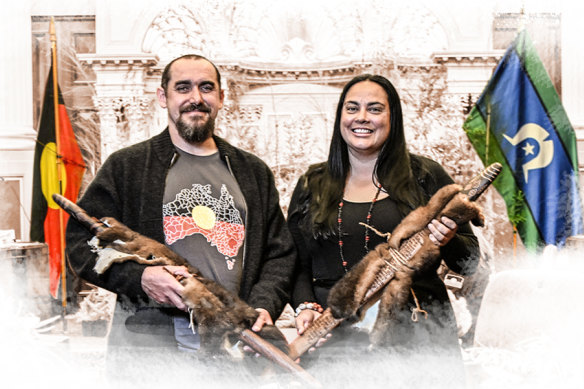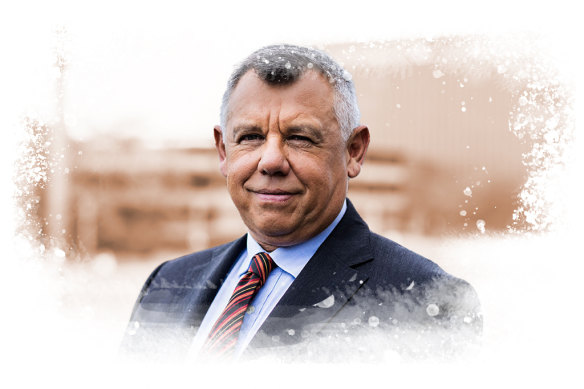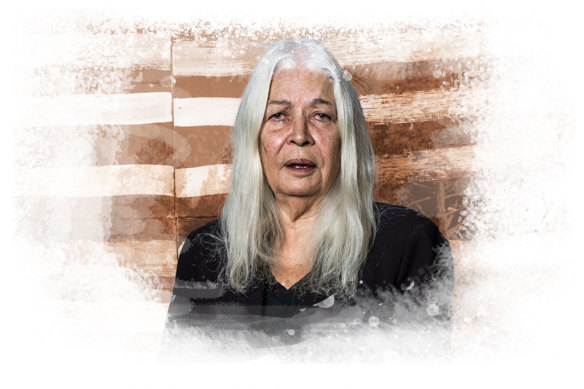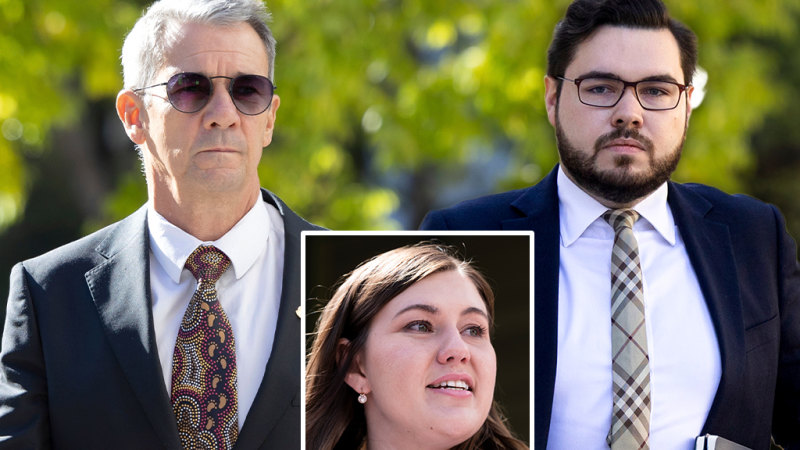Many countries have treaties with Indigenous peoples. Australia doesn’t, although some states have already moved towards establishing their own. What might they cover and could a federal one eventuate?
Save articles for later
Add articles to your saved list and come back to them any time.
The words came on the radio and the television – so goes the Yothu Yindi song Treaty. The then prime minister Bob Hawke agreed to negotiate Australia’s first treaty with First Nations people by 1990.
As it turned out, a policy of reconciliation took priority instead. “Promises can disappear, just like writing in the sand,” went the lyrics. The chorus caught on – “treaty yeah, treaty now” – but there was no treaty to come.
Guwamu woman Cheryl Buchanan says these were dark years after the prospect of a treaty faded. “Social justice issues come to the fore, then they’re lost, and then they come up again, and then they’re lost,” says Buchanan, who was among the first campers at the Aboriginal Tent Embassy outside Parliament House in Canberra in 1972. “We’ve had to keep pushing forward.”
Today, treaty negotiations have never appeared more likely as nearly all states and territories commit to pursuing them, along with truth-telling about historical injustices. Victoria and Queensland are the most advanced. A sense of hope is building for Buchanan, co-chair of Queensland’s Interim Truth and Treaty Body, which was set up last year to advise the state on how to proceed. “There are great opportunities here for our people.”
Meanwhile, in Canberra in the past fortnight, the prospect of a treaty following the establishment of a Voice to Parliament has been raised, with the Coalition – which broadly opposes the Voice – questioning the federal government on the matter. In turn, the government has attempted to deflect the questions by pointing out that processes for treaty-making are already under way in several states.
What is an Indigenous treaty? What would a treaty or treaties with First Nations Australians look like? And is the Voice a precursor?
Cheryl Buchanan: “We’ve had to keep pushing forward.” Credit: Rhett Wyman (digital altered)
First, what’s an Indigenous treaty?
Treaties have helped world leaders to end wars with one another, to agree to stop nuclear proliferation, to negotiate trade, to commit to emissions reduction targets. But international treaties are different from those between governments and Indigenous people. These treaties help provide a structure for resolving ongoing differences after settlers have colonised lands.
“[They] are agreements, essentially, where the parties come together, discuss how they can resolve differences and set down an agreed framework for living together more positively,” says George Williams, a professor at the University of NSW and co-author of the book Treaty. “The aspiration of treaties is to achieve a just coexistence.”
Australia is the only Commonwealth country with an Indigenous population that doesn’t have a treaty with that population. This is partly because no treaty with the Crown was entered into when colonists arrived in the late 18th century, Williams says, and neither were they negotiated as settlements expanded. Some settlers did make agreements. John Batman, for example, claimed to have negotiated a treaty with Wurundjeri people in 1835 to hand over land in present-day Melbourne for items including blankets, clothing and flour. But even if the Aboriginal individuals involved regarded the treaty in the same way as Batman, he was not acting on behalf of the Crown and his treaty was quickly deemed invalid.
Half a century after the British arrived in Australia, in 1840 in New Zealand they entered into the Treaty of Waitangi with about 540 Maori chiefs. The Maoris sought to protect their interests as the British sought to secure the Crown’s position in New Zealand. Since 1975, a tribunal has been dealing with claims where the Crown is alleged to have breached the treaty’s principles. The circumstances of the Waitangi Treaty’s creation were very different to those in Australia. The treaty itself is three articles, far less complex than modern treaties with First Nations people. “Historic treaties are first-principles treaties. They’re saying, ‘We’ll engage this way, you can have this, we’ll have that and good luck to each other,’” says Harry Hobbs, an associate professor of human rights law at University of Technology Sydney.
A treaty between the United States and the Six Nations of the Iroquois League signed at Fort Stanwix in 1784.Credit: US National Archives
The United States government also struck several hundred historic treaties with American Indian Nations between 1778 and 1871, mostly to establish peace and land boundaries, before Congress ended this kind of treaty-making. “Often broken, sometimes coerced, treaties still define mutual obligations between the United States and Indian Nations,” notes the National Museum of American Indians. Canada recognises 70 historic treaties covering land rights and peace agreements and has 26 modern treaties, which aim to address historical injustices.
Uluru Dialogue co-chair Megan Davis is cautious about comparing historical treaties overseas with what treaties might be able to achieve today. “One of the problems I have with the way treaties have been done is people have created really unrealistic expectations about what a treaty will be able to achieve,” she says. “Because a treaty [in Australia] is an ordinary act of parliament it will be very limited with what it can do and achieve.”
A modern treaty has three main elements, based on the United Nations Declaration on the Rights of Indigenous Peoples, says Hobbs. First, the agreement acknowledges that Indigenous peoples are a distinct political community: “They’re not just Australian citizens, but they are something different as well: they could be Wurundjeri, they could be Wiradjuri, they could be Wik … they’ve got this distinct community.” Second, the agreement must be reached by a process of negotiation between equals. Last, it has a concrete outcome that recognises unceded sovereignty and a degree of self-governance. “It needs to provide for some exercise of that right in the modern-day situation,” Hobbs says.
In Canada, for example, the Nisga’a treaty is comprehensive: it provides for a government that makes laws including over the administration of itself, management of Nisga’a lands and assets and Nisga’a language, culture and citizenship. These laws operate alongside existing laws; the treaty sets out how to resolve any conflicts and inconsistencies between laws.
Nisga’a people and officials at the dedication of their government building in New Aiyansh, Canada, in 2000.Credit: WikiCommons
Sydney senior counsel and Wirdi man Tony McAvoy, who is the former acting Northern Territory treaty commissioner, says self-governance can vary in practice. “In remote parts of Australia, self-governance will be something entirely different to the self-governance that First Nations can carry out in the capital cities,” he says. “So the system has to understand that and have the flexibility to accommodate the aspirations of the various First Nations.”
Several legal experts, including Williams and Hobbs, argue that the Western Australian South West Native Title Settlement (known also as the Noongar settlement) is the nation’s first treaty. The settlement, reached in 2021, includes recognition of the Noongar people through an act in the WA parliament and the transfer of up to 320,000 hectares of Crown land into the Noongar Boodja Trust. Over 12 years, the WA government pays $50 million annually to a trust managing assets for six Noongar corporations, and $10 million to the corporations for their operations. “I’d say it’s kind of a lowercase-T treaty,” Hobbs says. Others say the settlement is not a treaty because it didn’t go far enough to achieve self-governance and wasn’t negotiated through a formal treaty process.
Rueben Berg and Ngarra Murray are overseeing treaty negotiations with the Victorian government.Credit: Justin McManus (digitally altered)
Where are treaties up to in Australia?
In 2019, the inaugural members of the First Peoples’ Assembly of Victoria met in the state’s upper house, possum skins draped across red seats, native flora screening the vice-regal chair. The assembly began to set up a negotiation framework for treaties with the state government.
Most states and territories are committed to pursuing treaty negotiations. Western Australia is holding out; former premier Mark McGowan said in 2022 he wanted to see a successful national Voice before the state aligned its framework. “It’s important we don’t confuse things. The aim is to ensure this referendum is successful first,” he said. NSW has also committed to a year-long consultation process after the Voice referendum.
As with most modern treaty negotiations, such as in Canada … an independent umpire, a Treaty Authority, will ensure deliberations are fair.
In the Northern Territory, McAvoy delivered a report last year recommending a treaty and truth-telling commission. The government has not acted on this so far, finding there was no consensus view on what treaty framework is best for the state, but says it is “continuing the treaty journey”. South Australia has legislated a state-based Voice to parliament – an election for First Nations people will occur in March to determine members – while the state says it is committed to pursuing treaties.
Queensland passed a Path to Treaty Bill in June to create a First Nations Treaty Institute, overseen by a 10-person First Nations Council, and a formal Truth-telling and Healing Inquiry. There are more than 150 First Nations groups in Queensland; Buchanan says groups will work with the institute to discuss what they want to negotiate. “We have to get some consensus on these things, and I don’t think that’s going to happen overnight,” she says.
Victoria is the furthest ahead with a framework for treaty negotiations. The assembly has 32 members representing five regions across the state. Members are elected through two systems: communities in particular regions elect 22 of the representatives, and there are 11 reserved seats for specific traditional owner groups. (This number can expand, and one seat is currently vacant.)
As with most modern treaty negotiations, such as in Canada, the government and assembly have established an independent umpire, a Treaty Authority, that will ensure parties are prepared to negotiate and deliberations are fair. “You can’t have an entity that’s part of the state because they’re clearly not independent,” says assembly co-chair Rueben Berg. The authority was created through Victorian law, but also gets its power from both parties signing up to the framework.
Separately, Victoria’s Yoorrook Justice Commission is facilitating truth-telling, with a final report due in 2025. Berg says truth-telling is an important part of treaty negotiations because it can make recommendations about what needs to change. “Uncovering and understanding all those truths and injustices is a way of saying, ‘This is why we need a treaty,’” he says.
Megan Davis says truth-telling can help develop broad support for treaties, which have to pass through parliament. “You are going to have to get both sides of parliament on board,” she says. At a state level, treaty processes have bipartisan support in Queensland and Victoria, although not in NSW.
Tony McAvoy: “[Treaties] haven’t brought about any economic crash.”
What could the treaties cover?
The Victorian First Peoples’ Assembly believes treaty negotiations could start in 2024; its vision is for one treaty between the state and the assembly on statewide matters. This could cover anything from granting the assembly greater powers to appointing board members to the Victorian Aboriginal Heritage Council (currently a power that sits with the minister) or some state land being returned for Aboriginal management. “There’s nothing, automatically by default, that’s off the table. But it has to be reached in an agreement between the two parties,” Berg says.
The assembly also wants to empower traditional owner groups to negotiate multiple treaties at a local level. This could include anything from dual-naming of places such as Melbourne or Wilsons Promontory to increasing representation for First Nations people on local councils. Berg is wary of the view that treaties and forms of self-governance could be perceived to create “a separate society that’s just for Aboriginal people”. “That’s not the aspiration,” he says. “We know there are discrepancies in outcomes for our people. So we need dedicated approaches to improve those outcomes.”
Meanwhile, opponents of any federal treaty, including the federal Liberal and National parties, argue not only is it divisive, but it could lead to costly financial settlements. “I am opposed to a treaty because it is just more division,” says Country Liberal Party senator Jacinta Nampijinpa Price. “Countries don’t sign treaties with their own citizens. So far, talk of treaty is all one-way, it involves governments paying financial reparations and other form of compensation, but a treaty is an agreement between two parties, it establishes obligations for both sides.”
Compensation is a necessary part of treaties though, McAvoy says. “It’s well known to everybody that operates in this field that the possession of rights to self-determination can be meaningless if there isn’t the economic wherewithal to exercise it.” There are various ways to compensate for unresolved issues. McAvoy cites one example where, for 15 years from 1984, the NSW Aboriginal Land Rights Act provided that an amount equivalent to 7.5 per cent of NSW land tax (on non-residential land) goes to the NSW Aboriginal Land Council for compensation for land lost. Since 1998, the land council network has been self-supporting.
Many … recall opponents of the Mabo decision in the 1990s raising fears it would lead to claims over private land. ‘None of those things eventuated. The same is going to be the case here.’
Compensation is actually already paid to First Nations groups under the terms of Australian laws via other agreements. The Noongar settlement in WA includes a total of $800 million in compensatory benefits over 12 years. “It’s not just treaties that do this; treaty is just one word for a settlement of the issues,” says Professor Marcia Langton, the Associate Provost at the University of Melbourne. “We already have a lot of those in Australia in Indigenous land use agreements and other settlements.”
Many involved in preparing for treaty negotiations recall opponents of the Mabo decision in the 1990s raising fears it would lead to claims over private land. “None of those things eventuated. The same is going to be the case here,” says Berg. “We might be talking about public land that’s going to be returned to traditional owners so they can better manage it, so that’s a better resource for everybody.” (The High Court ruled in the Mabo decision that the notion of terra nullius was invalid, creating a foundation for native title in Australia.)
McAvoy says treaties could be effective in negotiating land for First Nations groups without homelands, too. “A treaty process should seek, where possible, to ensure that people have the capacity to live together on Country; on lands that they own,” he says.
Reports to the government of British Columbia in the 1990s predicted treaties would have net benefits for taxpayers. “They haven’t brought about any economic crash,” McAvoy says. “In fact, they have supported economic development.”
Marcia Langton: “We don’t want anarchy, we want … arrangements that are stable and predictable and rule-governed.”Credit: Tim Bauer (digitally altered)
Is the Voice vote a precursor to a federal treaty?
A national referendum on an Indigenous Voice to parliament will take place in Australia within months. With campaigns for the Yes and No cases under way, treaties have gained national attention because of the possibility for agreement-making to follow if the referendum is successful. In 2017, the Uluru Statement from the Heart called first for a Voice, but also set out the possibility for a Makarrata Commission to “supervise a process of agreement-making between governments and First Nations and truth-telling about our history”.
The statement has a sequence, says Davis, a constitutional lawyer who was key in designing the dialogue process for it: a referendum on the Voice and then the creation of a Makarrata Commission. If the referendum is successful, she says, it will be up to the Voice what it chooses to focus on, but presumably it could work towards setting up a commission. “Some time over the next decade, the Voice may work towards the creation of a Makarrata Commission,” says Davis. What role the commission could play in agreement-making is not yet clear.
In the past fortnight, the Opposition has quizzed the government about whether there could be a federal treaty with First Nations people. The government, wanting to remain focused on the Voice, has not yet indicated whether it would seek treaty negotiations at a federal level, instead pointing out treaty the processes already under way in states and territories. Says Davis: “Because state and territories are the preferred jurisdiction now for treaties, they need to be finalised at that level before anyone can contemplate what that looks like at a federal level.” One role the commission could have is to “provide coherency to those processes in those jurisdictions,” she says.
UNSW’s George Williams suspects treaties in Australia will “largely be negotiated at a state level”. He agrees with Davis that even if a Makarrata Commission is created, it will be overseeing state and local processes. “It’s possible and quite likely we’ll need both tiers of government involved because of the overlapping responsibilities,” he adds. “But we are talking about very specific agreements about matters relating to local communities.”
Modern treaties in Canada show negotiations can take up to 20 years before agreement is reached, Williams says. “Victoria and Queensland both have gone for years before getting into more active stages because there’s work to consult, build up capacity and build trust,” he says. “If there was a Voice, and [then] there was a move to treaty, that would roll out over a number of years.”
Although treaty negotiations can take a long time, Marcia Langton says some change has already been delivered through this process in Victoria. “The treaty assembly set up the Yoorrook Justice and Truth Telling Commission, which has also been very useful and has led to, for instance, an apology from the police commissioner for certain events,” she says. “There was also an apology from an official over the removal of children. That’s a change of attitude that will lead to better outcomes.”
Langton believes this is “where real change happens”. “Our real interests are represented by official bodies like the First Peoples’ Assembly … We don’t want anarchy, we want institution-to-institution arrangements that are stable and predictable and rule-governed.”
Fascinating answers to perplexing questions delivered to your inbox every week. Sign up to get our Explainer newsletter here.
If you'd like some expert background on an issue or a news event, drop us a line at [email protected] or [email protected]. Read more explainers here.
Most Viewed in National
Source: Read Full Article

